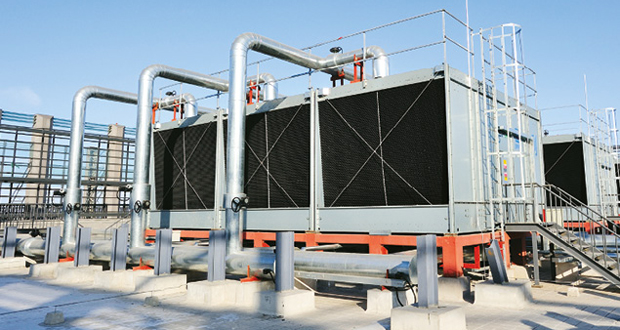 There are several competing cooling technologies, but to find the most sustainable solution, you need to look beyond efficiency alone, and consider the asset’s whole life cost, explains Carl Turbitt, HVAC Drives UK Sales Manager, ABB
There are several competing cooling technologies, but to find the most sustainable solution, you need to look beyond efficiency alone, and consider the asset’s whole life cost, explains Carl Turbitt, HVAC Drives UK Sales Manager, ABB
For cooling fans in air handling units (AHUs), there are two main competing technologies: electronically commutated (EC) fans, and motor + standalone variable speed drive (VSD) arrangements. An EC fan is a self-contained assembly comprised of an electric motor, VSD, and fan, all integrated into one package, while a motor and VSD are installed and maintained as two separate devices.
In this sense, both technologies are arguably very similar, with the drive providing precise control over the motor’s speed based on actual demand. Both can significantly reduce energy usage compared to a fan running without any form of speed control. However, they do have key differences and to consider only the upfront price, or its theoretical efficiency, misses the bigger picture of how these devices operate in practice.
TWO DEVICES ARE BETTER THAN ONE
In an integrated solution like an EC fan, the proximity of the motor and drive can prevent the assembly from dissipating heat effectively. While having one self-contained device may seem convenient, this can actually lead to the breakdown of electronic devices within the variable speed drive and the insulation of the motor, which are typically the most common points of failure.
With a motor-drive package, both motor and drive can be situated separately, resulting in less heat accumulation. This lowers the likelihood of the assembly needing premature replacement, and ultimately improves its sustainability.
Failures to EC fans can also be more difficult and expensive to fix. EC fans are often made to measure and so must be replaced like-for-like. Moreover, when it comes to replacing an EC fan within an array, you will often be locked into a particular configuration and a particular manufacturer. This in turn could put you at the mercy of long lead times and supply chain issues. Conversely, if a drive or motor fails, it can typically be replaced off the shelf with a similar product from any major manufacturer, meaning very little downtime and greater flexibility to choose the drive and/or manufacturer that fits best with your system and cooling requirements.
ACTUAL OPERATING CONDITIONS
Another aspect to consider is the load profile, or how the fan is actually run on a day-to-day basis. EC fans can deliver good efficiency levels at peak loads, but in reality 99 per cent of all HVAC fan applications rarely run at peak loads, and only then in worst case scenarios. Conversely, a motor-drive arrangement tends to perform better at partial loads, which is typically how it will operate for the vast majority of the time.
EC fans have a limited power rating and cannot generate anything like as much torque as a standalone drive, therefore a fan array will typically require several of them to reach the required airflow levels. This could mean more potential points of failure. A separate drive and motor on the other hand can go up to 250 kW without breaking a sweat, providing more power with less complexity. EC fans often have to be over-dimensioned in terms of power to reach the nominal static pressure, and thus run far from their best efficiency point.
HARMONICS
Harmonics are not a widely understood concept outside of electrical engineering, yet they are a growing problem in the building services industry. Harmonics are disruptions to the voltage and current waveforms caused by introducing non-linear loads to the grid. The majority of electronics that have a power supply will generate harmonics to some extent, but often only in very small amounts. However, when you have a building full of such devices such as printers, computers, monitors and LED lighting, the level of harmonics on the grid can quickly accumulate. Excessive harmonics results in nuisance trips and malfunctioning equipment, as well as reduced system efficiency. It also generates heat, which can lead to premature equipment failure, as well as creating more work for the cooling system itself.
Like many electronic devices, both EC fans and VSDs generate harmonics. However, while modern VSDs have built-in mitigations, EC fans may not dependent on the offering. As such, an EC fan installation may also require the use of additional harmonic filters at an additional cost later down the line. ABB’s Ultra-Low Harmonic (ULH) VSDs on the other hand use active front end (AFE) technology to not only ensure optimal performance where harmonics are present on the grid, but also mitigate them at source, reducing harmonic content by up to 90 per cent compared to conventional VSDs.
IN SUMMARY
EC fans certainly have their place. For small single cell applications operating at peak loads they can provide an efficient cooling solution. However, for applications which require vast amounts of cooling, they may not be able to provide everything you need for an effective, reliable and sustainable solution. When you consider what you really need from your cooling system, a separate motor-drive package can often be the more cost-effective and sustainable option, with reduced whole life cycle costs.
To learn more about EC fans, VSDs and other competing cooling technologies, download ABB’s white paper: https://bit.ly/3IGQM89





